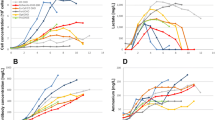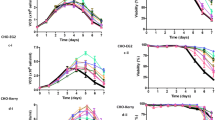Abstract
A serum free medium was developed for the production of recombinant antibody against Botulinum A (BoNTA) using dihydrofolate reductase deficient Chinese Hamster Ovary Cells (CHO-DG44) in suspension culture. An initial control basal medium was prepared, which was similar in composition to HAM’s F12: IMDM (1:1) supplemented with insulin, transeferrin, selenium and a lipid mixture. The vitamin concentration of the basal medium was twice that of HAM’s F12: IMDM (1:1). CHO-DG44 cells expressing S25 antibody grew from 2 × 105 cells to maximum cell density of 1.04 × 106 cells/ml after 5 days in this control medium. A central composite design was used to identify optimal levels and interaction among five groups of medium components. These five groups were glutamine, Essential Amino Acids (EAA), Non Essential Amino Acids (NEAA), Insulin, Transferrin, Selenium (ITS), and lipids. Fifty experiments were carried out in four batches, with two controls in each batch. There was little effect of ITS and Lipid concentrations over the range studied, and glutamine concentration showed a strong interaction with EAA. The optimal concentrations of the variables studied were 2.5 mM Glutamine, 7.4 mM (2×) EAA, 1.4 mM (0.5×) NEAA, 1× ITS supplement, 0.7× Lipids supplement. The maximum viable cell density attained in the optimized medium was 1.4 × 106 cells/ml, a 35% improvement over the control culture, while the final antibody titer attained was 22 ± 3.4 μg/mL, a 50% improvement.








Similar content being viewed by others
References
Box GEP, Hunter WG, Hunter JS (1978) Statistics for experimenters. Wiley, New York
Bretscher MS (1985) The molecules of the cell membrane. Sci Am 253:100–108
Castro PM, Hayter PM, Ison AP, Bull AT (1992) Application of a statistical design to the optimization of culture medium for recombinant interferon-gamma production by Chinese hamster ovary cells. Appl Microb Biotechnol 38:84–90
Chen QH, He GQ, Ali MAM (2002) Optimization of medium composition for the production of elastase by Bacillus sp. EL31410 with response surface methodology. Enzyme Microb Technol 30:667–672
Darfler FJ, Insel PA (1983) Clonal growth of lymphoid cells in serum-free media requires elimination of H2O2 toxicity. J Cell Physiol 115:31–36
DasGupta BR, Sathyamoorthy VS (1984) Purification and amino acid composition of type A botulinum neurotoxin. Toxicon 22:415–424
Farrant J, Newton CA, North ME, Weyman C, Brenner MK (1984) Production of antibody by human B cells under serum-free conditions. J Immunol Methods 68:25–34
Franek F, Sramkova K (1996) Protection of B lymphocyte hybridoma against starvation-induced apoptosis: survival-signal role of some amino acids. Immunol Lett 52:139–144
Franz DR, Jahrling PB, Friedlander AM, McClain DJ, Hoover DL, Bryne WR, Pavlin JA, Christopher GW, Eitzen EM Jr (1997) Clinical recognition and management of patients exposed to biological warfare agents. JAMA: J Am Med Assoc 278:399–411
Freshney RI (1994) Culture of animal cells: a manual of basic technique, 3rd edn. Wiley J. Liss, New York, pp 85–98
Gill DM (1982) Bacterial toxins: a table of lethal amounts. Microbiol Rev 46:86–94
Giovanni M (1983) Response surface methodology and product optimization. Food Technol 12:41–45
Glassy MC, Tharakan JP, Chau PC (1988) Serum-free media in hybridoma culture and monoclonal antibody production. Biotechnol Bioeng 32:1015–1028
Hayter PM, Curling EM, Baines AJ, Jenkins N, Salmon I, Strange PG, Bull AT (1991) Chinese hamster ovary cell growth and interferon production kinetics in stirred batch culture. App Microbiol Biotechnol 34:559–564
Houng JY, Chen KC, Hsu WH (1989) Optimization of cultivation medium composition for isoamylase production. Appl Microbiol Biotechnol 31:61–64
Keen MJ, Rapson NT (1995) Development of a serum-free culture medium for the large scale production of recombinant protein from a Chinese hamster ovary cell line. Cytotechnology 17:153–163
Kovar J, Franek F (1984) Serum-free medium for hybridoma and parental myeloma cell cultivation: a novel composition of growth-supporting substances. Immunol Lett 7:339–345
Lang AB, Cryz SJ Jr, Schurch U, Ganss MT, Bruderer U (1993) Immunotherapy with human monoclonal antibodies. Fragment A specificity of polyclonal and monoclonal antibodies is crucial for full protection against tetanus toxin. J Immunol (Baltimore, Md.: 1950) 151:466–472
Maddox IS, Richert SH (1977) Use of response surface methodology for the rapid optimization of microbiological media. Jo Appl bacteriol 43:197–204
Mather JP, Sato GH (1979) The growth of mouse melanoma cells in hormone-supplemented, serum-free medium. Exper Cell Res 120:191–200
Mowry MC, Meagher MM, Smith L, Marks J, Subramanian A (2004) Production and purification of a chimeric monoclonal antibody against botulinum neurotoxin serotype A. Protein Expr Purif 37:399–408
Myers RH, Montgomery DC (1995) Response surface methodology: process and product optimization using designed experiments. Wiley, New York
Nielsen FH, Uthus EO, Hunt CD (1981) Interactions between the “newer” trace elements and other essential nutrients. Proc NZ Workshop Trace Elem N Z, 165–173
Nowakowski A, Wang C, Powers DB, Amersdorfer P, Smith TJ, Montgomery VA, Sheridan R, Blake R, Smith LA, Marks JD (2002) Potent neutralization of botulinum neurotoxin by recombinant oligoclonal antibody. Proc Nat Aca Sci USA 99:11346–11350
Oeyaas K, Ellingsen TE, Dyrset N, Levine DW (1994) Utilization of osmoprotective compounds by hybridoma cells exposed to hyperosmotic stress. Biotechnol Bioeng 43:77–89
Reitzer LJ, Wice BM, Kennell D (1979) Evidence that glutamine, not sugar, is the major energy source for cultured HeLa cells. J Biol Chem 254:2669–2679
Schubert D (1979) Insulin-induced cell-substratum adhesion. Exper Cell Res 124:446–451
Senanayake SPJN, Shahidi F (2002) Lipase-catalyzed incorporation of docosahexaenoic acid (DHA) into borage oil: optimization using response surface methodology. Food Chem 77:115–123
Sinacore MS, Charlebois TS, Harrison S, Brennan S, Richards T, Hamilton M, Scott S, Brodeur S, Oakes P et al (1996) CHO DUKX cell lineages preadapted to growth in serum-free suspension culture enable rapid development of cell culture processes for the manufacture of recombinant proteins. Biotechnol Bioeng 52:518–528
Syuto B, Kubo S (1981) Separation and characterization of heavy and light chains from Clostridium botulinum type C toxin and their reconstitution. J Biol Chem 256:3712–3717
Zang M, Trautmann H, Gandor C, Messi F, Asselbergs F, Leist C, Fiechter A, Reiser J (1995) Production of recombinant proteins in Chinese hamster ovary cells using a protein-free cell culture medium. Bio/technology (Nature Publishing Company) 13:389–392
Zielke HR, Zielke CL, Ozand PT (1984) Glutamine: a major energy source for cultured mammalian cells. Federation proceed 43:121–125
de Zengotitia VM, Abston LR, Schmelzer AE, Shinie S, Miller WM (2002) Selected amino acids protect hybridoma and CHO cells from elevated carbondioxide and osmolality. Biotechnol Bioeng 78:741–752
Author information
Authors and Affiliations
Corresponding author
Rights and permissions
About this article
Cite this article
Parampalli, A., Eskridge, K., Smith, L. et al. Developement of serum-free media in CHO-DG44 cells using a central composite statistical design. Cytotechnology 54, 57–68 (2007). https://doi.org/10.1007/s10616-007-9074-3
Received:
Accepted:
Published:
Issue Date:
DOI: https://doi.org/10.1007/s10616-007-9074-3




